In order to understand all the ins and outs of how we communicate, communication theorists have developed different models of communication that illustrate how the process plays out.
By taking different perspectives and analyzing various communication models, we can learn a lot on how to assess and improve our current communication situation.
In the words of US communication theorist Harold D. Lasswell, the theorists’ task is to answer the question:
“Who says what to whom with what effect?”
In this guide, we will:
- Introduce you to the models of communication that are most frequently encountered in the literature,
- Explain how these models help with workplace communication, and
- Dive deep into major models of communication and explain them in detail.
Without further ado, let’s begin!

What are communication models?
According to Denis McQuail’s book Mass Communication Theory, “a model is a selective representation in verbal or diagrammatic form of some aspect of the dynamic process of mass communication.”
In other words, models of communication provide us with a visual representation of the different aspects of a communication situation.
Since communication is a complex process, it’s often challenging to determine where a conversation begins and ends. That is where models of communication come in — to simplify the process of understanding communication.
Some models are more detailed than others, but even the most elaborate ones cannot perfectly represent what goes on in a communication encounter.
How can communication models help with work communication?
Since communication is the lifeblood of any organization, we have to strive to understand how it works.
Understanding communication models can help us:
- Think about our communication situations more deliberately,
- Learn from our previous experiences, and
- Better prepare for future communication situations.
Do you remember the last time you had a misunderstanding with a colleague?
Was the workplace miscommunication caused by a wrongly interpreted tone of a message?
Or, maybe the email you had sent to your coworker ended up in the spam folder, so they didn’t even get it?
Whatever the misunderstanding was, we have to come to terms with the fact that some communication encounters are successful, others not so much.That is why we have so many current communication models we can use to plan successful communication situations.
—
After learning what communication models are and why they are important for our workplace communication, let’s take a closer look at the 8 models of communication.
8 Major communication models
There are 8 major models of communication, which can be divided into 3 categories:
- Linear models of communication — They only look at one-way communication. The most prominent linear models of communication are:
- Aristotle’s communication model,
- Lasswell’s communication model,
- The Shannon-Weaver communication model, and
- Berlo’s S-M-C-R communication model.
- Interactive models of communication — They analyze two-way communication. These are the following:
- The Osgood-Schramm communication model, and
- The Westley and Maclean communication model.
- Transactional models of communication — They illustrate two-way communication where the message gets more complex as the communication event progresses. These include:
- Barnlund’s transactional communication model, and
- Dance’s Helical communication model.
In the following paragraphs, we will analyze each of these models in detail, starting with linear models.
Linear models of communication
The linear communication model is straightforward and used mainly in marketing, sales, and PR, in communication with customers.
What is a linear model of communication?
Linear communication models suggest that communication takes place only in one direction.
The main elements in these models are:
- The channel,
- The sender, and
- The receiver.
Some linear models of communication also mention noise as one of the factors that have a role in the communication process. Noise acts as the added (background) element that usually distracts from the original message.
But, we’ll talk more about the role of noise in the communication process later on. For now, let’s start with the basic elements of the linear communication model.
As illustrated in the linear communication model diagram below, this communication model is pretty straightforward.
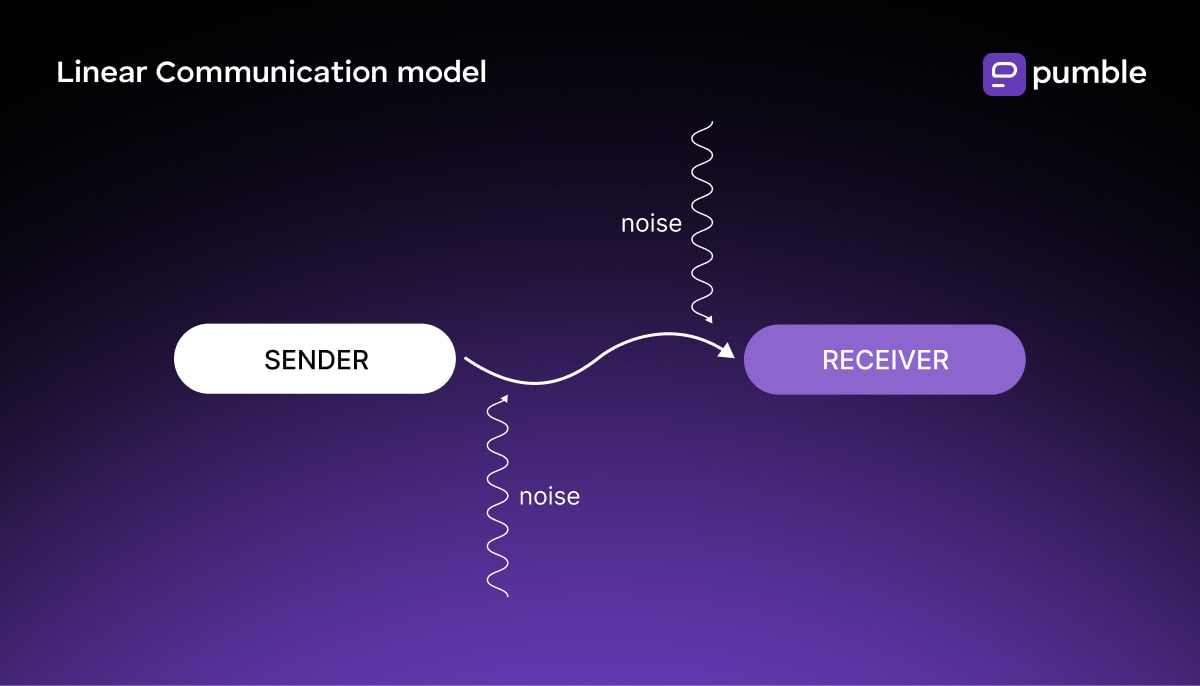
Simply put, the sender transmits the message via a channel.
The channel, as the medium, changes the message into speech, writing, or animation.
The message then finally reaches the receiver, who decodes it.
Now, it is time to analyze each one of the 3 most prominent linear models of communication in more detail.
1. Aristotle’s model of communication
Being the oldest communication model that dates back to 300 BC, Aristotle’s model was designed to examine how to become a better and more persuasive communicator.
What is Aristotle’s model of communication?
Aristotle’s model of communication primarily focuses on the sender (public speaker, professor, etc.) who passes on their message to the receiver (the audience).
The sender is also the only active member in this model, whereas the audience is passive. This makes Aristotle’s communication model a foolproof way to excel in public speaking, seminars, and lectures.
What are the main elements of Aristotle’s communication model?
Aristotle identified 3 elements that improve communication within this model:
- Ethos — Defines the credibility of the speaker. The speaker gains credibility, authority, and power by being an expert in a field of their choice.
- Pathos — Connects the speaker with the audience through different emotions (anger, sadness, happiness, etc.)
- Logos — Signifies logic. Namely, it is not enough for the speech to be interesting — it needs to follow the rules of logic.
As shown in Aristotle’s communication model diagram below, Aristotle also suggested that we look at 5 components of a communication situation to analyze the best way to communicate:
- Speaker,
- Speech,
- Occasion,
- Target audience, and
- Effect.
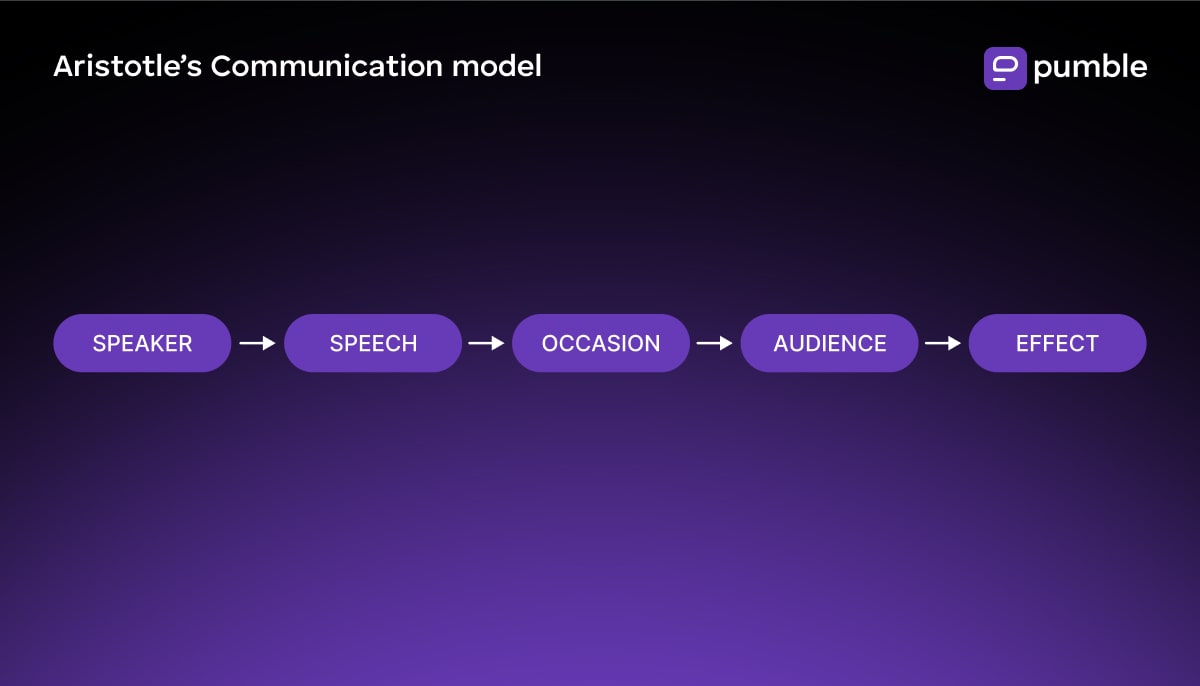
Aristotle’s communication model example
Picture this:
Professor Hustvedt is giving a lecture on neurological disorders to her students.
She delivers her speech persuasively, in a manner that leaves her students mesmerized.
The professor is at the center of attention, whereas the audience — her students — are merely passive listeners. Nevertheless, her message influences them and makes them act accordingly.
So, in this situation, professor Hustvedt is the speaker, and her lecture on disorders is the act of speech.
The occasion in question is a university lecture, while the students are her target audience.
The effect of her speech is the students gaining knowledge on this subject matter.
One of the major drawbacks of this model is that it does not pay attention to the feedback in communication because the audience is passive.
2. Lasswell’s model of communication
The next linear model on our list is Lasswell’s model of mass communication.
What is Lasswell’s model of communication?
Lasswell’s communication model views communication as the transmission of a message with the effect as the result.
The effect in this case is the measurable and obvious change in the receiver of the message, caused by the elements of communication.
If any of the elements change, the effect also changes.
What are the main elements of Lasswell’s communication model?
Lasswell’s model aims to answer the 5 following questions regarding its elements:
- Who created the message?
- What did they say?
- What channel did they use (TV, radio, blog)?
- To whom did they say it?
- What effect did it have on the receiver?
The answers to these questions offer us the main components of this model:
- Communicator,
- Message,
- Medium,
- Audience/Receiver, and
- Effect.
If we take a look at Lasswell’s communication model diagram below, we can better understand how these main components are organized.
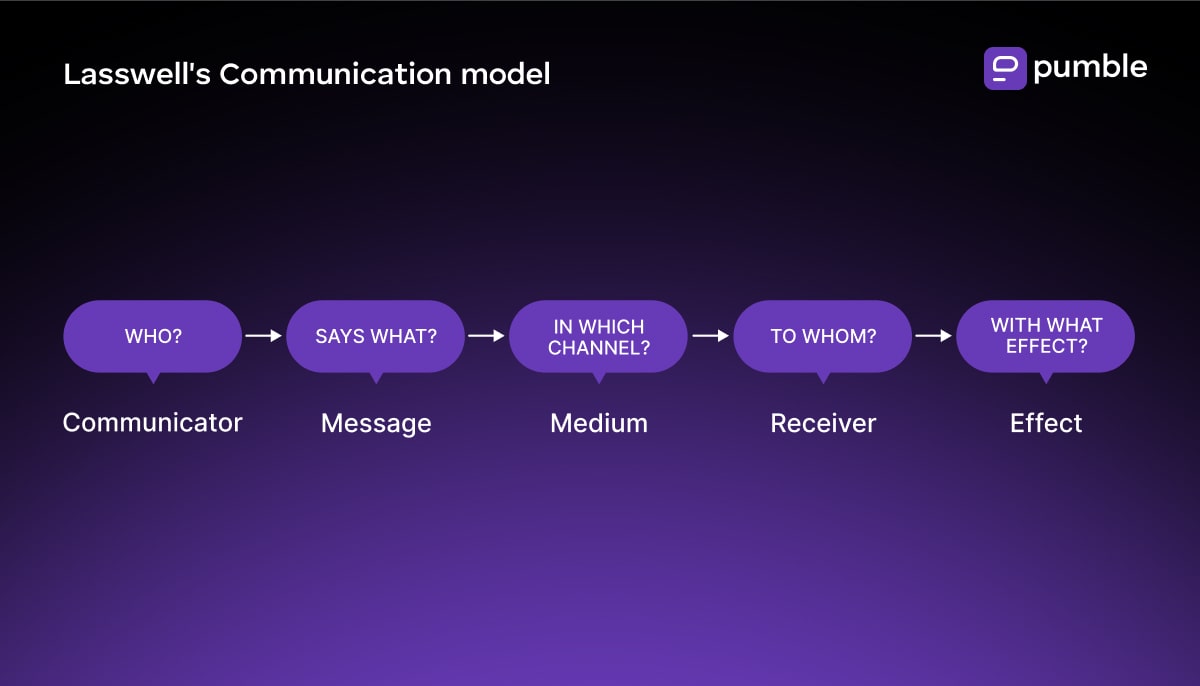
Lasswell’s communication model example
Let’s say you are watching an infomercial channel on TV and on comes a suitcase salesman, Mr. Sanders.
He is promoting his brand of suitcases as the best. Aware that millions of viewers are watching his presentation, Mr. Sanders is determined to leave a remarkable impression.
By doing so, he is achieving brand awareness, promoting his product as the best on the market, and consequently increasing sales revenue.
So, in this instance, Mr. Sanders is the communicator.
The message he is conveying is the promotion of his brand of suitcases as the best.
The medium he uses is television.
His audience consists of evening TV viewers in the US.
The effect he is achieving by doing this is raising brand awareness and increasing sales revenue.
3. The Shannon-Weaver model of communication
Maybe the most popular model of communication is the Shannon-Weaver model.
Strangely enough, Shannon and Weaver were mathematicians, who developed their work during the Second World War in the Bell Telephone Laboratories. They aimed to discover which channels are most effective for communicating.
So, although they were doing research as part of their engineering endeavors, they claimed that their theory is applicable to human communication as well.
And, they were right.
What is the Shannon-Weaver model of communication?
The Shannon-Weaver communication model, therefore, is a mathematical communication concept that proposes that communication is a linear, one-way process that can be broken down into 5 key concepts.
What are the main elements of the Shannon-Weaver communication model?
As the Shanon-Weaver communication model diagram below shows, the main components of this model are:
- Sender,
- Encoder,
- Channel,
- Decoder, and
- Receiver.
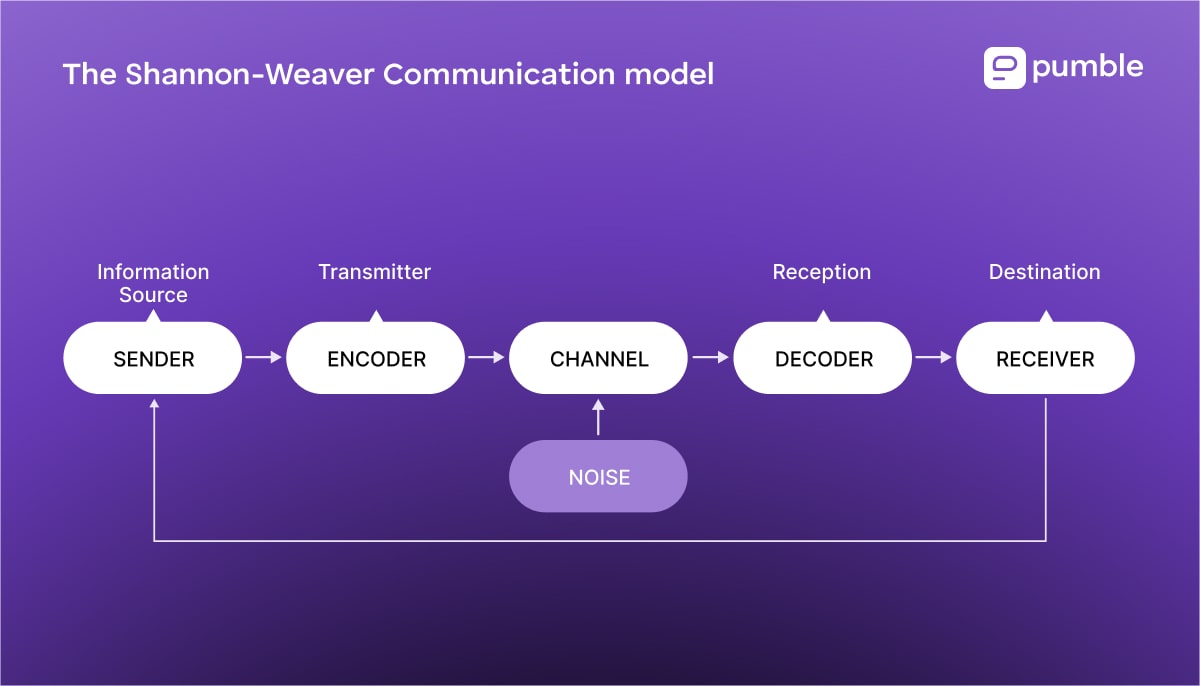
Shannon and Weaver were also the first to introduce the role of noise in the communication process. In his book Introduction to Communication Studies, John Fiske defines noise as:
“Anything that is added to the signal between its transmission and reception that is not intended by the source.”
The noise appears in the form of mishearing a conversation, misspelling an email, or static on a radio broadcast.
The Shannon-Weaver communication model example
Paula, a VP of Marketing in a multinational company, is briefing Julian on new marketing strategies they are about to introduce next month.
She wants a detailed study of the competitor’s activity by the end of the week.
Unfortunately, while she was speaking, her assistant Peter interrupted her, and she forgot to tell Julian about the most important issue.
At the end of the week, Julian did finish the report, but there were some mistakes, which had to be corrected later on.
Let’s take a moment to briefly analyze this example.
Paula is the sender, her mouth being the encoder.
The meeting she held was the channel.
Julian’s ears and brain were decoders, and Julian was the receiver.
Can you guess Peter’s role?
Yes, he was the noise.
The issue in this process was the lack of feedback. Had Julian asked Paula for clarification after Peter interrupted her, the whole communication process would have been more effective, and there would have been no mistakes.
Updated version of the Shannon-Weaver communication model
Since the original version didn’t include it, the principle of feedback was added to the updated version, so the model provided a more truthful representation of human interaction.
The concept of feedback was derived from the studies of Norbert Wiener, the so-called father of cybernetics.
Simply put, feedback is the transfer of the receiver’s reaction back to the sender.
It allows the speaker to modify their performance according to the reaction of the audience.
Maybe the most important function of feedback is the fact that it helps the receiver feel involved in the communication process.
That makes the receiver more receptive to the message, because they feel their opinion is being taken into account.
🎓 Pumble Pro Tip
In addition to being an important element in this communication model, feedback is also an integral part of effective workplace communication. To find out more about why it’s essential and how to practice it in the workplace, take a look at our resources:
4. Berlo’s S-M-C-R model of communication
Berlo’s model of communication was first defined by David Berlo in his 1960 book The Process of Communication.
This communication model is unique in the sense that it gives a detailed account of the key elements in each step.
What is Berlo’s S-M-C-R model of communication?
Simply put, Berlo’s S-M-C-R communication model is a linear model of communication that suggests communication is the transfer of information between 4 basic steps or key elements.
What are the main elements of Berlo’s Berlo’s S-M-C-R communication model?
As shown in Berlo’s S-M-C-R communication model diagram below, these steps are the following:
- Source,
- Message,
- Channel, and
- Receiver.
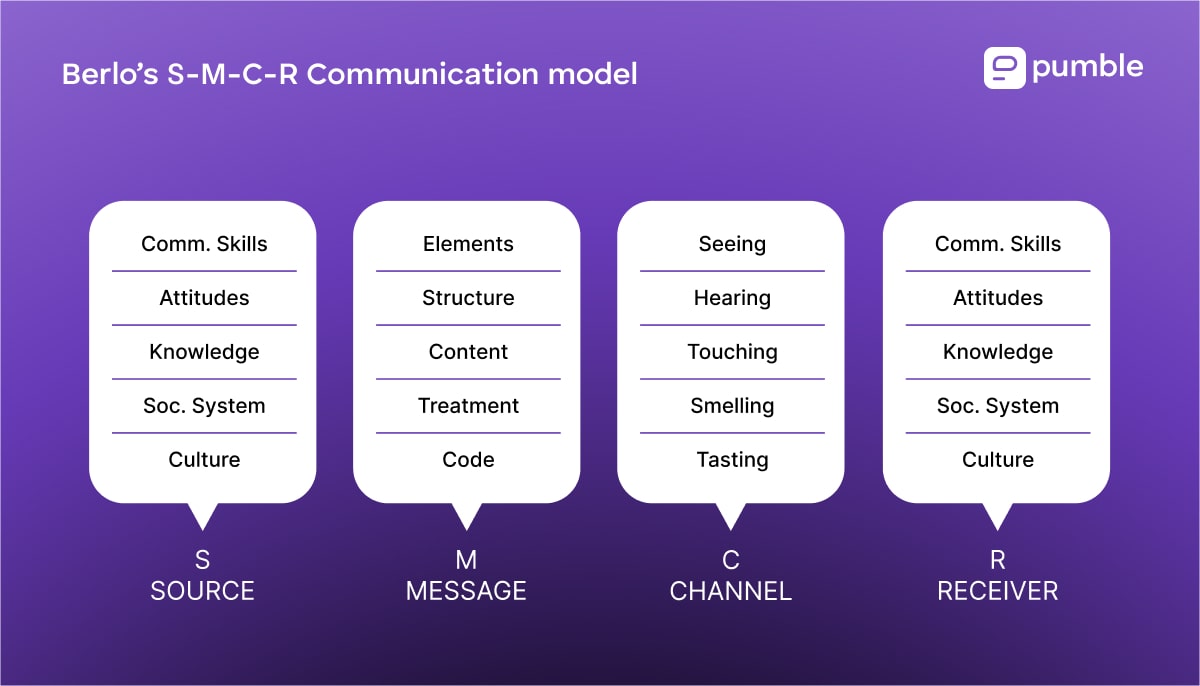
Let’s consider the key elements that affect how well the message is communicated, starting with the source.
Step #1: The source
The source or the sender carefully puts their thoughts into words and transfers the message to the receiver.
So, how does the sender transfer the information to the receiver, according to Berlo’s S-M-C-R communication model?
With the help of:
- Communication skills — First and foremost, the source needs good communication skills to ensure the communication will be effective. The speaker should know when to pause, what to repeat, how to pronounce a word, etc.
- Attitude — Secondly, the source needs the right attitude. Without it, not even a great speaker would ever emerge as a winner. The source needs to make a lasting impression on the receiver(s).
- Knowledge — Here, knowledge does not refer to educational qualifications but to the clarity of the information that the source wants to transfer to the receiver.
- Social system — The source should be familiar with the social system in which the communication process takes place. That would help the source not to offend anyone.
- Culture — Last but not least, to achieve effective communication, the source needs to be acquainted with the culture in which the communication encounter is taking place. This is especially important for cross-cultural communication.
🎓 Pumble Pro Tip
For more on how to improve cross-cultural communication and adapt to the global workforce, learn all about cultural intelligence and how to improve it in our blog post:
Step #2: The message
The speaker creates the message when they transform their thoughts into words.
Here are the key factors of the message:
- Content — Simply put, this is the script of the conversation.
- Elements — Speech alone is not enough for the message to be fully understood. That is why other elements have to be taken into account: gestures, body language, facial expressions, etc.
- Treatment — The way the source treats the message. They have to be aware of the importance of the message so that they can convey it appropriately.
- Structure — The source has to properly structure the message to ensure the receiver will understand it correctly.
- Code — All the elements, verbal and nonverbal, need to be accurate if you do not want your message to get distorted and misinterpreted.
Step #3: The channel
To get from the source to the receiver, the message goes through the channel.
Berlo’s S-M-C-R communication model identifies all our senses as the channels that help us communicate with one another.
Our sense of hearing lets us know that someone is speaking to us.
Through our sense of taste, we gather information about the spiciness of a sauce we are eating.
Our sense of sight allows us to decipher traffic signs while driving.
We decide whether we like a certain perfume or not by smelling it.
By touching the water we feel whether it is too cold for a swim.
Step #4: The receiver
A receiver is a person the source is speaking to — the destination of the conveyed message.
To understand the message, the receiver should involve the same elements as the source. They should have similar communication skills, attitudes, and knowledge, and be acquainted with the social system and culture in which they communicate.
Berlo’s S-M-C-R communication model example
Watching the news on television is the perfect example of Berlo’s S-M-C-R Model of communication.
In this case, the news presenter is the source of the news and they convey the message to the audience.
The news is the message, the television is the channel, and the audience are the receivers of the message.
Since we have become acquainted with linear models of communication, let’s move on to something a little more complex and dynamic — interactive models of communication.
Interactive models of communication
Interactive models are used in internet-based and mediated communication such as telephone conversations, letters, etc.
What is an interactive model of communication?
As more dynamic models, interactive communication models refer to two-way communication with feedback.
However, feedback within interactive communication models is not simultaneous, but rather slow and indirect.
What are the main elements of interactive communication models?
The main elements of these models, illustrated in the interactive communication model diagram, include the following:
- Sender,
- Message,
- Receiver,
- Feedback, and
- Field of experience.
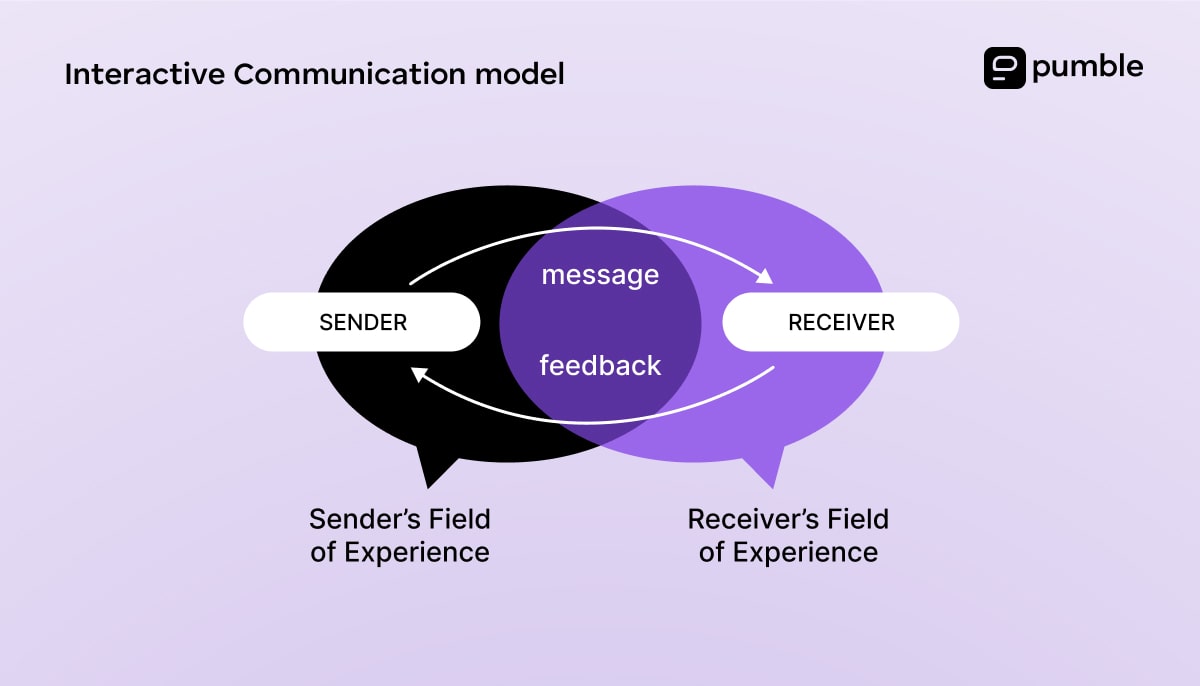
You probably noticed the new, previously not seen element — field of experience.
The field of experience represents a person’s culture, past experiences, and personal history.
All of these factors influence how the sender constructs a message, as well as how the receiver interprets it. Every one of us brings a unique field of experience into communication situations.
Let’s go over the most noteworthy interactive models of communication in greater detail.
5. The Osgood-Schramm model of communication
In their book Communication Models for the Study of Mass Communications, Denis Mcquail and Sven Windahl say that the emergence of this model “meant a clear break with the traditional linear/one-way picture of communication.”
What is the Osgood-Schramm model of communication?
The Osgood-Schramm model is a circular model of communication, in which messages go in two directions between encoding and decoding.
As such, this model is useful for describing synchronous, interpersonal communication, but less suitable for cases with little or no feedback.
Interestingly, in the Osgood-Schramm communication model, there is no difference between a sender and a receiver. Both parties are equally encoding and decoding the messages. The interpreter is the person trying to understand the message at that moment.
Furthermore, the Osgood-Schramm communication model shows that information is of no use until it is put into words and conveyed to other people.
What are the main principles and steps in the communication process according to this model?
The Osgood-Schramm communication model proposes 4 main principles of communication:
- Communication is circular. Individuals involved in the communication process are changing their roles as encoders and decoders.
- Communication is equal and reciprocal. Both parties are equally engaged as encoders and decoders.
- The message requires interpretation. The information needs to be properly interpreted to be understood.
- As shown in the Osgood-Schramm communication model diagram below, this model proposes 3 steps in the process of communication:
- Encoding,
- Decoding, and
- Interpreting.
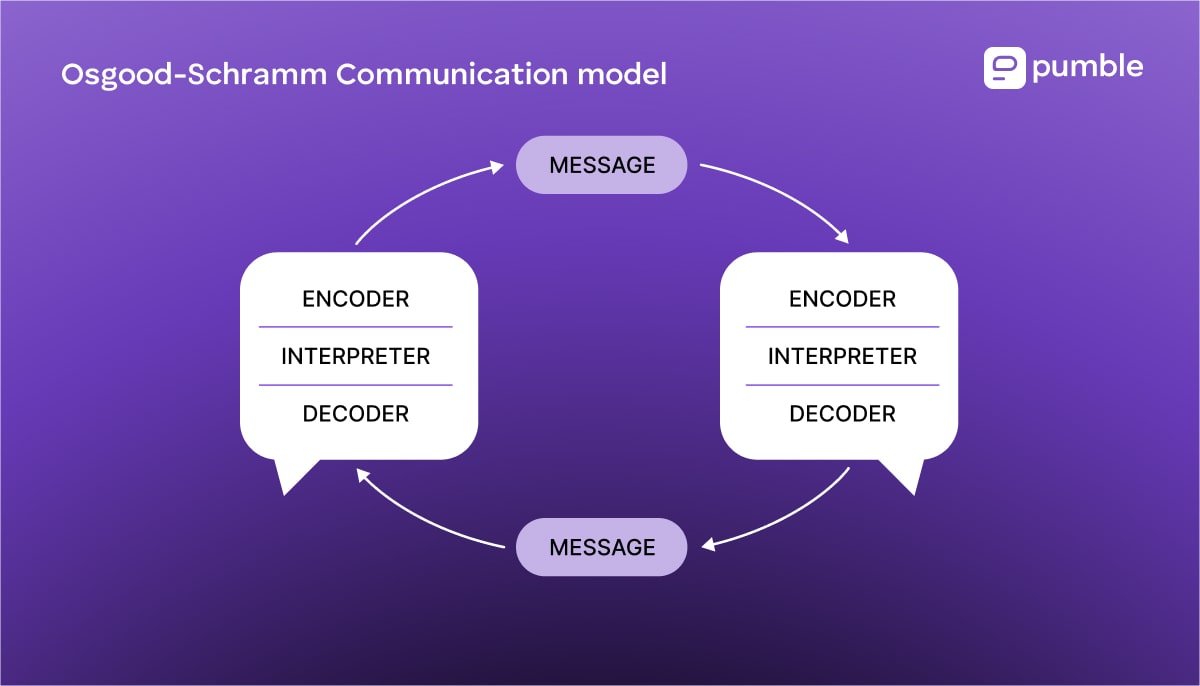
The Osgood-Schramm communication model example
Imagine you have not heard from your college friend for 15 years. Suddenly, they call you, and you start updating each other about what happened during the time you have not seen each other.
In this example, you and your friend are equally encoding and decoding messages, and your communication is synchronous. You are both interpreting each other’s messages.
In Information Theory and Mass Communication, Schramm even says:
“It is misleading to think of the communication process as starting somewhere and ending somewhere. It is really endless. We are really switchboard centers handling and re-routing the great endless current of information.”
6. The Westley and Maclean model of communication
The next interactive communication model on our list is the Westley and Maclean model of communication.
This communication model is primarily used for explaining mass communication.
What is the Westley and Maclean communication model?
The Westley and Maclean model of communication suggests that the communication process does not start with the source/sender, but rather with environmental factors.
This model also takes into account the object of the orientation (background, culture, and beliefs) of the sender and the receiver of messages.
The very process of communication, according to this communication model, starts with environmental factors that influence the speaker — the culture or society the speaker lives in, whether the speaker is in a public or private space, etc.
Aside from that, the role of feedback is also significant.
What are the main elements of the Westley and Maclean communication model?
This model consists of 9 crucial components:
- Environment (X),
- Sensory experience (X¹),
- Source/Sender (A),
- The object of the orientation of the source (X²),
- Receiver (B),
- The object of the orientation of the receiver (X³),
- Feedback (F),
- Gatekeepers (C), and
- Opinion leaders.
The Westley and Maclean communication model diagram below shows how these components are organized in the communication process.

The Westley and Maclean communication model example
Imagine that on your way to the office, you witness a road accident.
This is the type of stimulus that would nudge you to call your friends and tell them about what you had seen, or call your boss to say you are going to be a bit late.
So, the communication process in this example does not start with you, but with the road accident you have witnessed.
Acknowledgment of the environmental factors in communication, therefore, allows us to pay attention to the social and cultural contexts that influence our acts of communication.
—
Now that we have seen what the elements of communication in this model are, let’s look at all of them in greater detail.
9 Key elements of communication in the Westley and Maclean communication model
As mentioned above, this model shows that the communication process does not start from the sender of the message, but rather from the environment.
So, we will start with this element.
Element #1: Environment (X)
According to the Westley and Maclean model, the communication process starts when a stimulus from the environment motivates a person to create and send a message.
Element #2: Sensory experience (X¹)
When the sender of the message experiences something in their environment that nudges them to send the message, then that sensory experience becomes an element of communication.
In the example above, the sensory experience would be witnessing a road accident.
Element #3: Source/Sender (A)
Only now does the sender come into play.
In the above-mentioned example, you are the sender, as well as a participant in the interpersonal communication situation.
However, a sender can also be a newscaster sending a message to millions of viewers. In that case, we are talking about mass communication.
Element #4: The object of the orientation of the source (X²)
The next element of communication in this model is the object of the orientation of the source.
Namely, the object of the orientation of the source is the sender’s beliefs or experiences.
If we take the previously-mentioned road accident as an example, you (A) are concerned (X²) that you are going to be late for work because of the accident (X¹), and that is why you are calling your boss (B).
Element #5: Receiver (B)
The receiver is the person who receives the message from the sender.
In mass communication, a receiver is a person who watches TV, reads a newspaper, etc.
When speaking about interpersonal communication, a receiver is a person who listens to the message.
In the example of a road accident, the receivers of the message are your friends and your boss.
Element #6: The object of the orientation of the receiver (X³)
The object of orientation of the receiver is the receiver’s beliefs or experiences, which influence how the message is received.
For example, your friend (B) watching the news is worried about your safety (X³) after receiving the message.
Element #7: Feedback (F)
Feedback is crucial for this model because it makes this model circular, rather than linear.
As a matter of fact, feedback influences how messages are sent.
That means that a receiver and a gatekeeper are sending messages back to the sender.
After they have received the feedback, the sender modifies the message and sends it back.
Let’s go back to our example (about the road accident).
So, you have witnessed the accident and feel the urge to call your best friend.
You: “There was a terrible accident downtown!”
Your friend: “My goodness! Are you hurt?”
You: “No, no, I just witnessed it. I wasn’t involved! Don’t worry!”
In this example, after the feedback from your worried friend, you modify your message and send it back to them.
Element #8: Gatekeepers (C)
This element usually occurs in mass communication, rather than in interpersonal communication.
Gatekeepers are editors of the messages senders are trying to communicate to receivers.
For example, these are newspaper editors who edit the message before it reaches the readers.
Element #9: Opinion leaders
Again, this element of communication refers to mass communication situations.
Namely, opinion leaders have an immense influence as an environmental factor (X) on the sender of the message (A).
These are political leaders, celebrities, or social media influencers.
We are now familiar with interactive models, so all we have left to analyze are the transactional communication models.
Transactional communication models
Transactional models are the most dynamic communication models, which first introduce a new term for senders and receivers — communicators.
What is a transactional communication model?
Transactional communication models view communication as a transaction, meaning that it is a cooperative process in which communicators co-create the process of communication, thereby influencing its outcome and effectiveness.
In other words, communicators create shared meaning in a dynamic process.
Aside from that, transactional models show that we do not just exchange information during our interactions, but create relationships, form cross-cultural bonds, and shape our opinions.
In other words, communication helps us establish our realities.
These models also introduced the roles of:
- Social,
- Relational, and
- Cultural contexts.
Moreover, these models acknowledge that there are barriers to effective communication — noise.
What are the main elements of transactional communication models?
By taking a look at the transactional communication model diagram below, we can identify the key components of this communication model:
- Encoding,
- Decoding,
- Communicators,
- The message,
- The channel, and
- Noise.
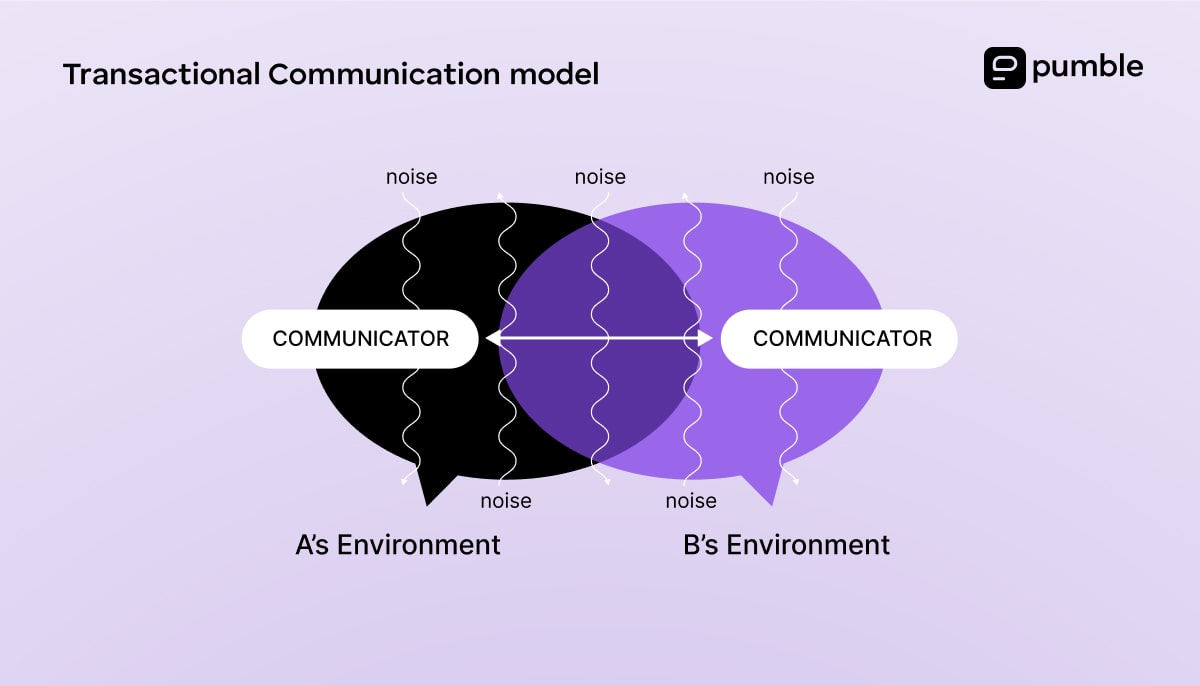
—
We have briefly mentioned the most prominent transactional models of communication — now it’s time to thoroughly analyze them.
7. Barnlund’s transactional model of communication
Barnlund’s transactional communication model explores interpersonal, immediate-feedback communication.
What is Barnlund’s transactional communication model?
Barnlund’s model of communication recognizes that communication is a circular process and a multi-layered feedback system between the sender and the receiver, both of whom can affect the message being sent.
The sender and the receiver change their places and are equally important. Feedback from the sender is the reply for the receiver, and both communicators provide feedback.
At the same time, both sender and receiver are responsible for the communication’s effect and effectiveness.
What are the main elements of Barnlund’s communication model?
Barnlund’s transactional communication model diagram below illustrates the following main components of this communication model:
- Encoding,
- Decoding,
- Communicators,
- The message (including the cues, environment, and noise), and
- The channel.
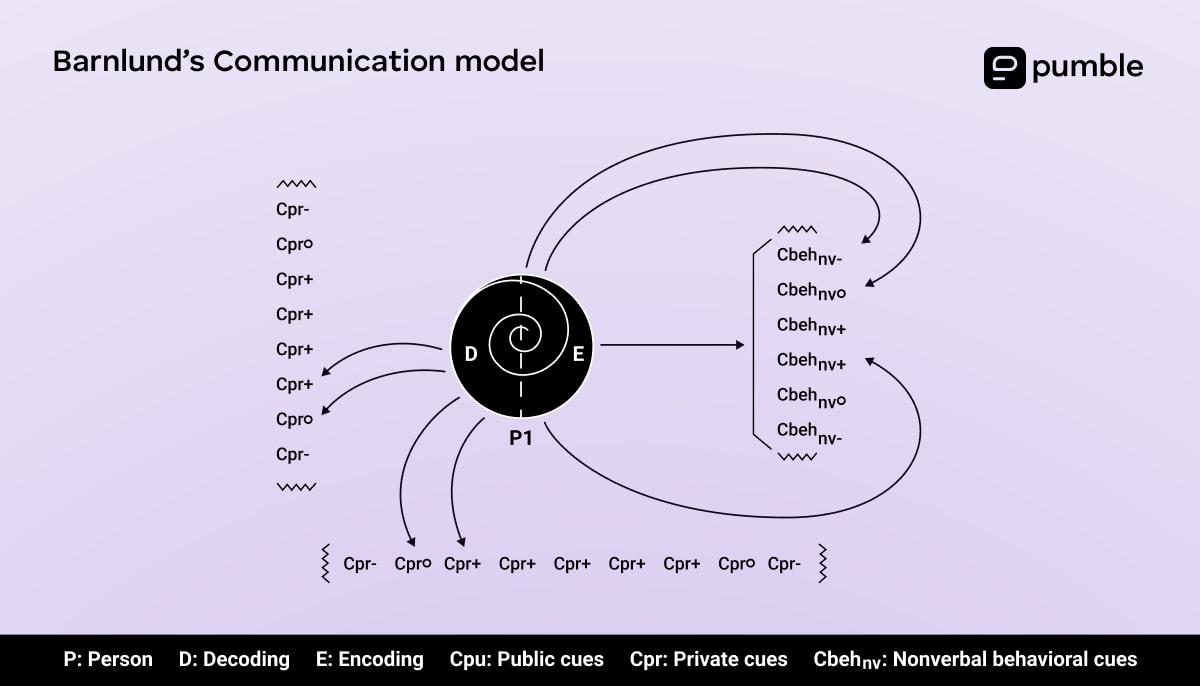
This model accentuates the role of cues in impacting our messages.
So, Barnlund differentiates between:
- Public cues (environmental cues),
- Private cues (communicator’s personal thoughts and background), and
- Behavioral cues (person’s behavior, that can be verbal and nonverbal).
All these cues, as well as the environment and noise, are part of the message. Each communicator’s reaction depends on their background, experiences, attitudes, and beliefs.
Barnlund’s transactional communication model example
Examples of Barnlund’s model of communication include:
- Face-to-face interactions,
- Chat sessions,
- Telephone conversations,
- Meetings, etc.
Let’s illustrate this model with an example from Pumble, a business messaging app.

Improve team communication with Pumble
Why was there a misunderstanding in this conversation, even though everything seemed fine at first glance?
This misunderstanding has arisen due to cultural cues.
Namely, Joan had thought that Natalie wanted a day off on July 4th.
However, Natalie comes from Norway and celebrates Independence Day on May 17th.
On that day, Natalie does not show up at work to Joan’s bewilderment, because she has expected Natalie to take a day off on July 4th, on US Independence Day.
So, due to cultural cues, there was a misunderstanding between them.
Still, this misunderstanding could have easily been avoided, had they cleared up the dates by providing each other with feedback.
8. Dance’s Helical model of communication
According to Dance’s Helical model of communication, with every cycle of communication, we expand our circle.
Therefore, each communication encounter is different from the previous one because communication never repeats itself.
What is Dance’s Helical communication model?
Dance’s Helical communication model views communication as a circular process that gets more and more complex as communication progresses.
That is why it is represented by a helical spiral in the Dance’s Helical communication model diagram below.
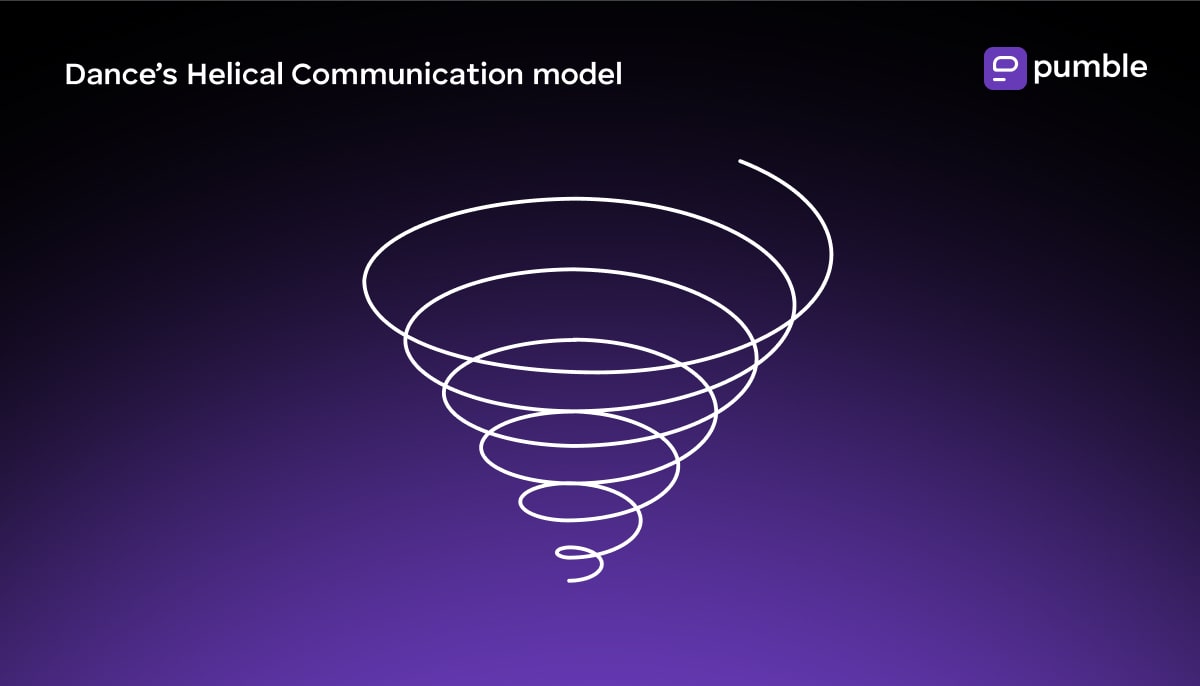
In their book Communication: Principles for a Lifetime, Steven A. Beebe, Susan J. Beebe, and Diana K. Ivy state:
“Interpersonal communication is irreversible. Like the spiral shown here, communication never loops back on itself. Once it begins, it expands infinitely as the communication partners contribute their thoughts and experiences to the exchange.”
According to this communication model, in the communication process, the feedback we get from the other party involved influences our next statement and we become more knowledgeable with every new cycle.
Dance’s Helical communication model example
Dance himself explained his model with the example of a person learning throughout their life.
Namely, a person starts to communicate with their surroundings very early on, using rudimentary methods of communication.
For instance, as babies, we cry to get our mothers’ attention. Later on, we learn to speak in words, and then in full sentences.
During the whole process, we build on what we know to improve our communication.
Every communication act is, therefore, a chance for us to learn how to communicate more effectively in the future, and feedback helps us achieve more effective communication.
In a way, our whole life is one communicational journey toward the top of Dance’s helix.
How communication models help us solve our workplace communication problems
Communication in real life might be too complex to be truly represented by communication models.
However, models of communication can still help us examine the steps in the process of communication, so we can better understand how we communicate both in the workplace and outside of it.
In this guide, we have covered the most important models of communication, divided into 3 categories:
- Linear models — Mainly used in marketing, sales, and PR, in communication with customers, these models view communication as a one-way process.
- Interactive models — Used in internet-based and mediated communication, they refer to two-way communication with indirect feedback.
- Transactional models — The most complex models of communication, which best reflect the communication process.
Although none of these models represent our communication 100%, they can help us detect and solve potential problems and improve our communication skills.
Implementing communication models with Pumble
Regardless of your type of business, in 2025, a dedicated team collaboration software can be used as a means to effectively communicate inside and outside of your team.
With a dedicated digital HQ like Pumble, you can minimize the effects of noise and rely on various types of communication to get your message across.
Some of Pumble’s features that simplify and improve team communication include:
- Channels — best for notifying multiple receivers at once, minimizing the chance for misinterpretation,
- Video conferencing — best for collaboration and brainstorming,
- Polls — best for encouraging passive participants to engage in a role of a sender, rather than remaining receivers, especially in a work setting where individual input matters.
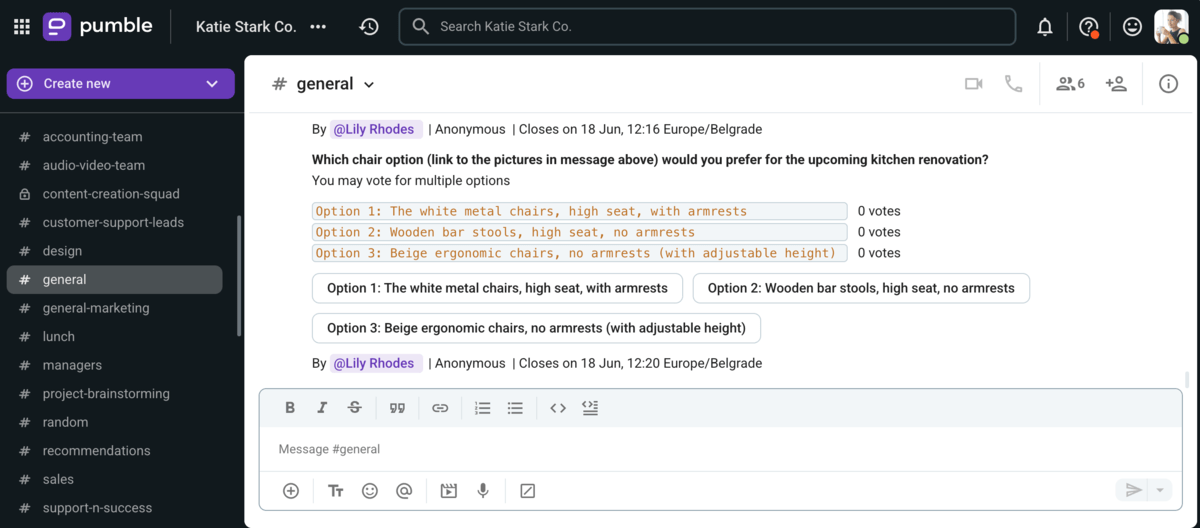
With these and plenty of other features, you can rest assured that your communication process will be greatly improved and simplified.
After analyzing your team’s communication efforts through the most appropriate model, picking the preferred communication method will be an intuitive and rewarding process.
Improve your communication today —
How we reviewed this post: Our writers & editors monitor the posts and update them when new information becomes available, to keep them fresh and relevant.




